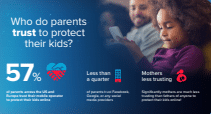Infographic: Why Parents Trust Mobile Operators to Safeguard Children Online
With lockdowns, mutations, new strains, second waves, etc; we are more dependent than ever on technology and the internet to stay connected. Children are now dependent on the internet for their education. Gone are the days when ‘screen-time’ was a well earnt and supervised privilege. It is now an unquestionable necessity for children’s education.
According to our Censuswide survey (read the press release here), which was conducted in April 2021, amongst 4000 parents in the US, UK, France, Germany, Italy and Spain – 44% of those aged 11-15 and 30% of those aged 6-10 spent between 3 and 6 hours browsing the internet unsupervised every day during lockdown.
As they were unsupervised, children could have been exposed to harmful content. Many parents are left helpless and confused when it comes to implementing parental controls whilst managing their own jobs during the turbulent times.
Who do parents trust?
Parents are looking for trusted technological solutions to do the job, with 70% of the parents saying they would be willing to pay between $5-14 dollars a month for such a service.
Most youngsters are generally tech-savvy, and device-based parental control products are just not cutting it anymore. They can be easy to circumvent. Our survey also revealed a general distrust parents have towards social media (i.e. Google, Facebook) and the government when it comes to parental control.
Churning parents
This is where mobile operators can play a pivotal role in offering direct network based parental controls (which are much harder to bypass). 56% of the parents surveyed stating that they would be willing to switch operators for one that offers parental controls at the same price.
Our infographic highlights some of the key findings from our survey.
7045 Parental-Controls Infographic v4
Future-proof safeguarding of children
Implementing such a system would be challenging for most operators considering the advancements in encryption protocols such as HTTPS and QUIC. Some existing parental control solutions could be rendered obsolete due to the growing adoption of TLS 1.3 with encrypted SNI later this year.
This is where Enea’s AI-based traffic classification system comes into play, which instantly identifies content based on statistical prediction, behavioral analysis and heuristics. Enea helps operators deliver parental control solutions that are both effective and future-proof.





